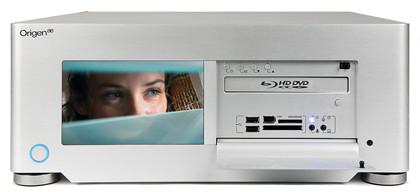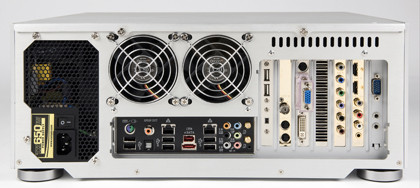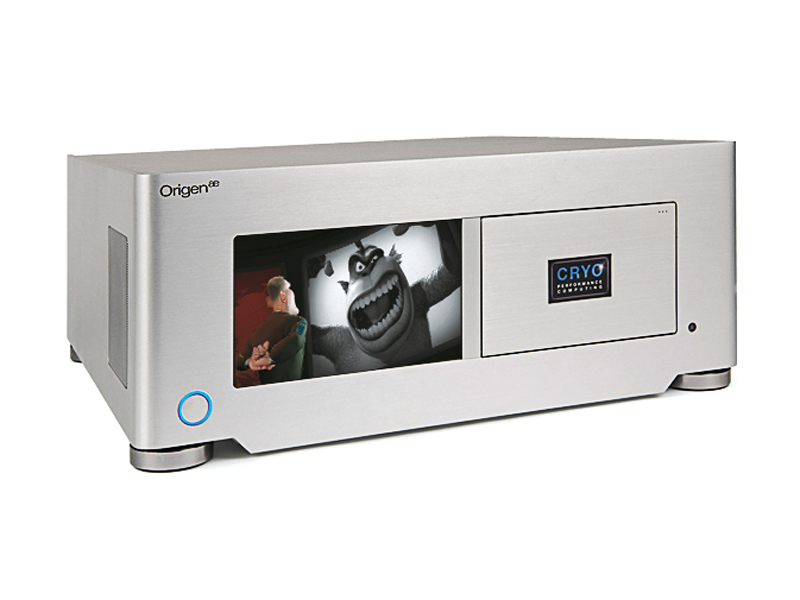TechRadar Verdict
A good HTPC system that can be configured at point of sale so you decide what exactly you will need
Pros
- +
Good performance
- +
Convenient touchscreen
Cons
- -
Some hardware design faults and inconvenient connection implementation
Why you can trust TechRadar
All Media Centre home cinema PCs have to satisfy in two areas – looks and performance. Home cinema users want performance comparable to a good Blu-ray player, but wouldn't be happy with a system in their living room which looks like a games player's acid nightmare. So Cryo has taken its experience in the games PC market, and applied it to a home cinema design, the Cryo HTPC.
Like most manufacturers in this field, Cryo suggests a basic system for each application, but makes it possible to customise the system according to needs and cost. Prices start at around £1,000 and go up to over £5,000 – the setup I'm reviewing here is a mid-range one costing around £2,450.
What all Cryo's HTPC systems have in common is the recognition that home cinema systems incorporating HD playback are surprisingly demanding of computer power. This necessitates advanced processing and cooling systems that run quietly.
Cryo's Boost technology combines overclocking (the process of running the system's digital clocking faster than the manufacturer intended), tuning of delay timer and buss speeds, and elimination of data bottlenecks. Cryo claims that the 3GHz CPU in this system runs at 4GHz, 33 per cent faster than specified.
Careful component selection and enhanced cooling is required to push it this hard, so the 650W power supply unit is accompanied by two 80mm fans drawing air from front to back.
The case hardware itself is rather plain, an Origen design finished in brushed aluminium with a rather perfunctory Cryo sticker applied. The most distinctive feature is a 7in LCD touchpanel.

By connecting a VGA loop-through, this can act as a touch-controller and supplementary monitor, so you don't have to switch on your main monitor and AV amp to use the PC.
The Windows 7 version of ArcSoft's Total Media Theatre software means you can now view a Blu-ray on an external monitor and the touchscreen at the same time – something not possible with Vista. An external 10-inch version is also available, which can be in sited in another location.
A flap with a push-latch covers the Cryo's disc tray, multiple format memory card slots and front USB sockets. Unfortunately, the latch doesn't open automatically when you try to eject the disc tray – an elementary design mistake, but there are alternatives available.
The rear of the PC is, of course, festooned with sockets and ports. The operating system is Windows 7, which incorporates the Media Center multimedia software.
All the usual Windows functions you would expect are available, including internet access, utility software and games-playing, but this system also includes DVD/BD playback, a digital/analogue TV tuner, surround sound processing, mass disc storage and remote control.
Built to rock
Cryo's main unit is around the size and weight of a typical home cinema AVR. The case can take full-length cards, so it would be easy to upgrade if necessary, but the accessories for the Cryo HTPC are carefully chosen for living-room use.
The system has a relatively small footprint, and uses an ATX motherboard. The central processor is a Core 2 Duo E8500, the motherboard is fitted with 4GB of DDR2 memory.
The design incorporates four Seagate 1.5Tb hard drives – one for the system software, three for storage in a RAID array, for a total of 6Tb – giving capacity for about 3,000 hours of SD video content. 8Tb of storage is an option.
The graphics card is a low-latency design from Asus, and the soundcard is a Xonar D2X 7.1-channel. The system can be fitted with a Hybrid TV quad-tuner or satellite receiver, and includes a Wi-Fi adapter built into the motherboard.
LG's GGC-H20L Blu-ray/DVD-RW burner will handle Blu-ray, DVD, CD, DVD-Audio and SACD, as well as a multiplicity of digital video and audio formats from disc. Asus again is responsible for the AV output card, a Xonar HDAV1.3, which has 7.1-channel analogue/digital outputs, and HDMI 1.3.

However, it's bafflingly complicated to get video and audio routed to the HDMI socket at the same time – it's much easier to use the HDCP compliant DVI sockets with an HDMI adaptor, and a separate digital audio output.
The built-in TI Burr-Brown DAC is good enough quality for most music playback requirements, but the optical/coaxial sockets can be set to output anything from 48Hz to 192Khz should you wish to use an external DAC.
Our review sample was setup to enter Windows Media Center immediately on booting; WMC is the front-end to a wide range of functions, including disc play; digital playback of audio, video and still image files from the hard drive; TV viewing, recording and playback; and 'net video and audio services.
In lieu of a conventional keyboard and mouse, you're offered a selection of no fewer than five controllers.
There's an Origen Windows Media Center remote with a conventional cursor and-keypad layout; a Logitech Mini Bluetooth keyboard, a wireless keyboard/mouse combination about the size of a standard remote control; a Logitech MX Air mouse, which can be used on a desk or in the air as a pointer, and includes media buttons and hand gesture volume control; an Xbox wireless game pad, including force feedback vibration; and finally a mini remote control unit which just controls volume and power.
Unfortunately, I found that some Blu-ray titles disabled mouse cursors, so the AirMouse was useless with them. While some multimedia PCs offer an onscreen virtual cursor to overcome this problem, here you have to swap to the other remote control.
Apart from the Windows 7 software, Cryo's package includes Windows Media Player for audio playback, CyberLink PowerDVD Ultra for DVD/Blu-ray, ArcSoft TotalMedia Theatre, and Spotify software for internet music playback.
The Xonar HDAV Center Deluxe utility is used to specify the audio output options. In tests, I had no problems with video playback quality, though our Tech Labs analogue audio jitter results were unspectacular whether from disc or digital, a common problem with PC-based systems.
Disc loading speeds aren't spectacular either; Java processing is swift but there's a lot of umming and ahhing to get through before you've even reached that stage.
Sophisticated system
Cryo's HTPC is an impressive multimedia system that doesn't make the mistake of trying to supplant your existing multichannel amplification system; it would fit nicely into a hi-fi rack, adding the sophistication of touchpanel control.
In terms of performance it rivals anything you could expect from a Blu-ray player, and, of course, gives full access to BD-Live functions via your network.
But Cryo doesn't seem to have quite grasped all the requirements of the home cinema market; the latching disc-tray lid, the naff Cryo sticker, the fiddly HDMI output, the HDCP-compliance problems and the Blu-ray cursor control are glitches which are bound to irritate most users.
They wouldn't take much sorting out, in which case a Cryo HTPC system could take its rightful place among the market leaders.
Follow TechRadar Reviews on Twitter: http://twitter.com/techradarreview
